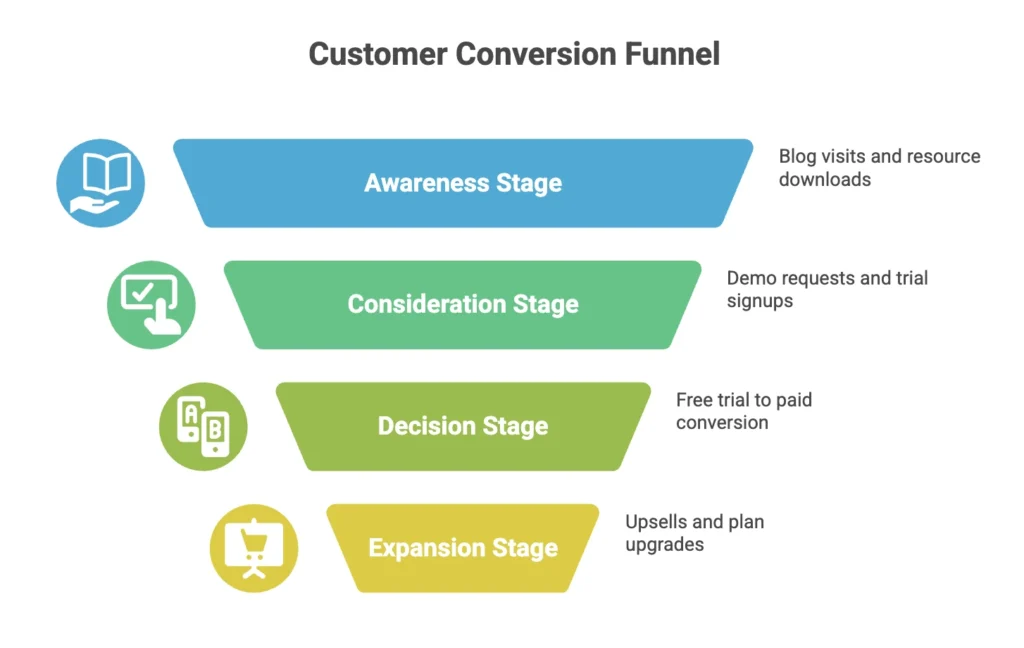Your content marketing budget needs to justify itself with hard revenue numbers, not vanity metrics. The question isn’t whether your blog posts get traffic, it’s whether they’re driving measurable Monthly Recurring Revenue (MRR) growth. Here’s how to connect your content investments directly to subscription revenue using attribution models, customer journey tracking, and MRR impact analysis that actually works.
The MRR Attribution Challenge
SaaS businesses face unique ROI measurement challenges because marketing leads may take months to convert to paying customers, and content often plays multiple touchpoints in the customer journey. Unlike e-commerce where purchase attribution is straightforward, SaaS content ROI requires tracking long sales cycles and multi-touch interactions.
The key is building measurement systems that connect content engagement to subscription revenue, accounting for the time lag between content consumption and revenue generation. This means tracking content-assisted conversions, not just last-click attribution.
Setting Up Content-to-MRR Tracking
The Foundation: UTM Parameter Strategy
Every piece of content needs proper tracking parameters to measure its revenue impact. Use this UTM structure for blog content:
Campaign naming convention:
utm_source=blogutm_medium=organic(oremailfor newsletter links)utm_campaign=content-topic-YYYY-MMutm_content=article-title-slug
This granular tracking lets you trace revenue back to specific content pieces and measure which topics drive the highest-value subscribers.
Customer Journey Mapping for Content ROI
Track conversion rates across the funnel from lead-to-customer and trial-to-paid to understand how marketing contributes to recurring revenue. Map out these key content touchpoints:
- Awareness stage: Blog visits, resource downloads
- Consideration stage: Demo requests, trial signups
- Decision stage: Free trial to paid conversion
- Expansion stage: Upsells and plan upgrades
Each stage needs measurement to calculate true content ROI on MRR growth.

Multi-Touch Attribution Models for SaaS Content
First-Touch Attribution for New Customer Acquisition
Marketing sourced revenue (MSR) using first-touch attribution sums up revenue generated from leads that originate specifically from marketing channels, such as content campaigns. This model gives full credit to the initial content piece that brought the customer into your funnel.
How to implement:
- Tag all content URLs with first-touch tracking
- Connect leads to their original content source
- Calculate MRR generated by first-touch content interactions
- Measure Customer Acquisition Cost (CAC) by content piece
Multi-Touch Attribution for Complex Sales Cycles
Google Analytics’ model comparison tool is the best way to measure content attribution as it assigns credit to each measurable interaction in the customer’s path to conversion. This approach recognizes that multiple content pieces contribute to subscription decisions.
Attribution models to test:
- Linear: Equal credit to all touchpoints
- Time decay: More credit to recent interactions
- Position-based: Extra credit to first and last touchpoints
- Data-driven: Google’s algorithmic attribution
Run these models in parallel to understand which content drives the most valuable customer segments.
MRR Impact Calculation Methods
Content-Assisted MRR Formula
Track content-assisted MRR to understand revenue impact from content touchpoints throughout the customer journey. Calculate this monthly:
Content-Assisted MRR = Total New MRR × Content Interaction Rate
Where Content Interaction Rate = Percentage of new customers who engaged with your content before subscribing.
Content ROI by Customer Segment
Not all MRR is equal. High-value customers often consume different content than low-value subscribers. Segment your analysis:
- Enterprise customers: Typically engage with in-depth guides, case studies, ROI calculators
- SMB customers: Often convert through product comparison posts, pricing guides
- Self-serve customers: Usually discover through educational content, how-to articles
Calculate separate ROI for each segment to optimize content strategy.
Advanced MRR Attribution Tracking
Cohort Analysis for Content ROI
Cohort analysis is particularly important in B2B SaaS but not used widely enough. Track customers who discovered you through content vs. other channels:
- Month 1: Initial MRR from content-sourced customers
- Month 6: MRR retention and expansion from the same cohort
- Month 12: Lifetime Value (LTV) comparison
Content-sourced customers often show higher retention rates and expansion revenue, increasing their true ROI beyond initial acquisition metrics.
Revenue Attribution by Content Type
Different content formats drive different revenue outcomes. Track MRR impact by:
- Educational content: How-to guides, tutorials, best practices
- Commercial content: Product comparisons, case studies, ROI tools
- Thought leadership: Industry reports, trend analyses, expert opinions
This breakdown reveals which content types generate the highest-value subscribers and inform budget allocation decisions.
Tools and Implementation
Google Analytics 4 Setup for SaaS Attribution
Configure GA4 to track subscription events as conversions:
- Create custom events for trial signups, subscription starts, plan upgrades
- Set up conversion tracking with revenue values for each subscription tier
- Build attribution reports showing content contribution to revenue goals
- Use Exploration Hub for detailed customer journey analysis
HubSpot Revenue Attribution
For HubSpot users, implement these tracking methods:
- Campaign attribution reports connecting content to closed deals
- Revenue dashboard showing MRR by original source
- Custom properties tracking content engagement scores
- Workflow automation tagging high-engaging content consumers
Specialized SaaS Attribution Tools
Consider tools designed specifically for SaaS revenue attribution:
- ChartMogul: Links subscription events to marketing touchpoints
- Profitwell: Tracks content impact on churn reduction and expansion revenue
- Mixpanel: Provides detailed user journey analysis from content to conversion
MRR Forecasting Based on Content Performance
Leading Indicators for Content ROI
Track these metrics as early MRR growth indicators:
- Content engagement depth: Time on page, scroll depth, return visits
- Lead quality scores: Engagement-based scoring for content leads
- Trial conversion rates: Content leads vs. other sources
- Free-to-paid velocity: Time from content engagement to subscription
Predictive MRR Modeling
Use historical data to forecast MRR impact from content investments:
- Analyze seasonal patterns in content-driven subscriptions
- Calculate conversion lag times from content engagement to revenue
- Model expansion revenue from content-educated customers
- Predict churn rates based on ongoing content engagement
Content Budget Allocation Based on MRR Data
ROI-Driven Content Planning
Allocate content budgets based on proven MRR impact:
- High-ROI content types: Double down on formats and topics showing strongest revenue attribution
- Audience segments: Invest more in content for high-LTV customer segments
- Distribution channels: Prioritize channels driving highest-value subscribers
- Content refresh strategy: Update and expand top-performing revenue-driving content
Performance Benchmarking
Establish content ROI benchmarks for your SaaS:
- Industry average: Content typically influences 20-40% of B2B SaaS deals
- Channel comparison: Compare content ROI against paid ads, direct sales
- Time-based analysis: Track ROI improvement as content marketing matures
- Competition analysis: Benchmark against industry content performance
Measuring Long-Term Content Value
Customer Lifetime Value Attribution
The true ROI of content extends beyond initial subscriptions. Track:
- Expansion revenue: Upsells and plan upgrades from content-educated customers
- Retention rates: How content engagement affects churn
- Referral generation: Word-of-mouth from content-influenced customers
- Organic growth: Brand searches and direct traffic increases
Content Asset Appreciation
High-performing content becomes more valuable over time through:
- Compounding organic traffic: Better search rankings drive consistent leads
- Link building: Quality content attracts backlinks, improving domain authority
- Social proof: Successful content builds brand credibility
- Sales enablement: Content becomes tools for closing deals
Building Your Content-to-MRR Dashboard
Create a monthly dashboard tracking these key metrics:
Revenue Attribution:
- Content-assisted MRR (target: 30%+ of new MRR)
- Content ROI by type (target: 3:1 minimum)
- Customer acquisition cost from content (target: lower than paid channels)
- Time from content engagement to subscription (track trends)
Performance Indicators:
- Lead quality scores from content (target: higher than average)
- Trial-to-paid conversion rates (target: 20%+ higher for content leads)
- Customer lifetime value by source (target: content LTV 25%+ higher)
- MRR expansion from content-sourced customers (track quarterly)
The goal is building a measurement system that proves content marketing’s direct impact on sustainable revenue growth, guiding strategic decisions with concrete MRR data rather than vanity metrics.
